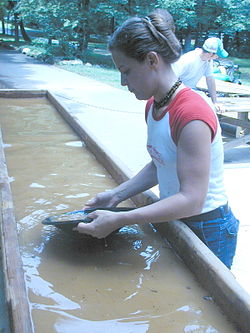- Reed Gold Mine
-
Reed Gold Mine
 Panning for gold at the mine
Panning for gold at the mineNearest city: Concord, North Carolina Built: 1799 Architect: Unknown Architectural style: No Style Listed Governing body: State NRHP Reference#: 66000587[1] Added to NRHP: October 15, 1966 The Reed Gold Mine is located in Midland, Cabarrus County, North Carolina, and is the site of the first documented commercial gold find in the United States.[2] It has been designated a National Historic Landmark because of its importance and listed on the National Register of Historic Places.
Contents
History
In 1799, Conrad Reed, the son of farmer and former Hessian soldier John Reed (né Johannes Reidt), found a 17-pound yellow "rock" in Little Meadow Creek on the family farm in Cabarrus County, North Carolina. For three years, the rock served as a bulky doorstop. In 1802, a jeweler from Fayetteville identified the rock as a large gold nugget. He told John Reed to name his price. Reed, not understanding the true value of gold, asked for what he thought was the hefty price of $3.50, or a week's worth of wages. The large nugget's true value was around $3,600.
About 1803, John Reed organized a small gold mining operation. Soon afterward a slave named Peter found a 28-pound nugget.[2] Reed continued with placer mining for a number of years. In 1831 he began underground mining. John Reed died rich in 1845 from the gold found on his property.
Some years later, the American Civil War decreased mining activity because of labor and resources being pulled into the war. The last large nugget uncovered by placer mining was discovered in 1896. The last underground mining took place at the Reed Mine in 1912. To handle the large amount of gold found in the region and state from the 19th into the early 20th century, the Charlotte Mint was built in nearby Charlotte, North Carolina.[2][3]
Today, the Reed Mine is a state historic site and open to the public. Visitors can tour a museum with extensive displays about North Carolina gold mining. In addition, they can explore several hundred feet of restored mine tunnels.
About John Reed
Johannes Reidt, a Hessian soldier from Raboldshausen, Germany, Born, January, 06, 1757, Salzberg Hesse Cassel Germany, [[mother, Anna Elizabeth Reid Her father, Johannes Reidt and mother, Anna Catherine Engel were married August 5, 1764 in Germany and his father, Johann Jacob Helmerich]] d. May 28, 1845, in Cabarrus County, N.C., served during the American Revolution in Company C (Col. Friedrich von Porbeck) of the Garrison Regiment von Wissenbach. On June 21, 1782 he deserted his post outside Savannah, Georgia and took his arms and equipment. It is thought, "JOHN REED", used his father-in-laws name. It is imprecise.
He went to 'upper' Mecklenburg County, North Carolina, later Cabarrus County, where he settled in the ethnic German community. He Anglicized his name to John Reed. Later he married Sarah Kiser, born in 1761 in Germany, daughter of Peter Kiser and Fanny Garmon, and died November 19, 1848 in Cabarrus County.
Further Information
American Society of Mechanical Engineers History & Heritage Landmarks Page
References
- ^ "National Register Information System". National Register of Historic Places. National Park Service. 2007-01-23. http://nrhp.focus.nps.gov/natreg/docs/All_Data.html.
- ^ a b c "Reed Gold Mine". North Carolina Historic Sites. http://www.ah.dcr.state.nc.us/sections/hs/reed/reed.htm. Retrieved 2006-12-19.
- ^ "Antebellum Gold Mining (1820-1860)". North Carolina History Project. http://www.northcarolinahistory.org/encyclopedia/59/entry. Retrieved 2006-12-19.
External links
- Reed Gold Mine - official site
U.S. National Register of Historic Places Topics Lists by states Alabama • Alaska • Arizona • Arkansas • California • Colorado • Connecticut • Delaware • Florida • Georgia • Hawaii • Idaho • Illinois • Indiana • Iowa • Kansas • Kentucky • Louisiana • Maine • Maryland • Massachusetts • Michigan • Minnesota • Mississippi • Missouri • Montana • Nebraska • Nevada • New Hampshire • New Jersey • New Mexico • New York • North Carolina • North Dakota • Ohio • Oklahoma • Oregon • Pennsylvania • Rhode Island • South Carolina • South Dakota • Tennessee • Texas • Utah • Vermont • Virginia • Washington • West Virginia • Wisconsin • WyomingLists by territories Lists by associated states Other Historic Sites Alamance Battleground • Aycock Birthplace • Historic Bath • Bennett Place • Bentonville Battlefield • Brunswick Town • Charlotte Hawkins Brown Museum • CSS Neuse • Duke Homestead • Historic Edenton • Fort Anderson • Fort Dobbs • Fort Fisher • Historic Halifax • Horne Creek Farm • House in the Horseshoe • North Carolina Transportation Museum • USS North Carolina Battleship Memorial • Old Salem • President James K. Polk Historic Site • Reed Gold Mine • Roanoke Island Festival Park • Somerset Place • Historic Stagville • North Carolina State Capitol • Town Creek Indian Mound • Tryon Palace • Zebulon B. Vance Birthplace • Thomas Wolfe Memorial •
Coordinates: 35°17′08″N 80°28′12″W / 35.28542°N 80.46996°W
Categories:- Historic districts in North Carolina
- Protected areas of Cabarrus County, North Carolina
- Geology of North Carolina
- Gold mines in the United States
- Gold rushes
- National Historic Landmarks in North Carolina
- 1799 establishments in the United States
- Surface mines in the United States
- Museums in Cabarrus County, North Carolina
- Mining museums in North Carolina
- Industry museums in North Carolina
- Mines in North Carolina
- North Carolina State Historic Sites
Wikimedia Foundation. 2010.
